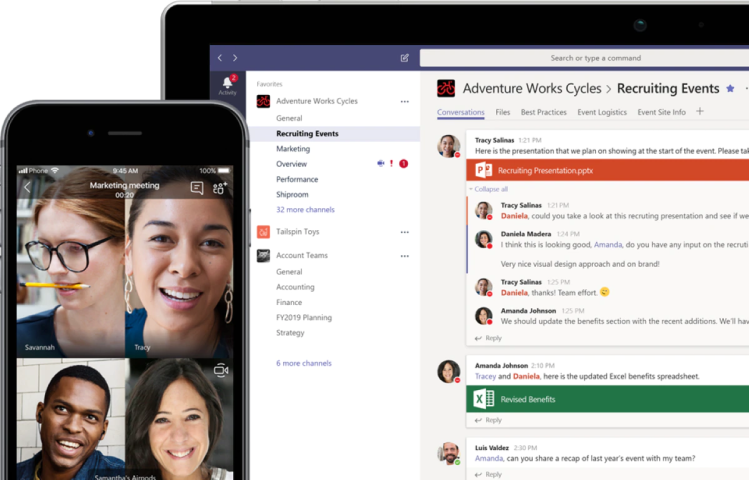Microsoft announced some pretty notable growth stats for its Teams collaboration software this week, revealing that it now claims 20 million daily active users (DAUs) — an increase of nearly 55% on the 13 million it reported back in July.
By way of context, Slack recently announced that it now has 12 million daily users, up from the 10 million it announced in January, half of whom are on paid plans. Workplace by Facebook recently claimed 3 million paying users, up from 2 million in February. Facebook also offers a free service for Workplace, but the company doesn’t break out its numbers.
Looking at the top-line numbers, Microsoft Teams is demonstrating some impressive growth, but that likely doesn’t convey the full story. For starters, Microsoft hasn’t broken down the active user base for its non-paying users after launching a free incarnation last year. Moreover, the way it defines an active user has been called into question by some, including Slack cofounder and CEO Stewart Butterfield, who told CNBC last month: “They’re not comparing the same thing when they say ‘daily active user.'”
Active users
According to Microsoft, the company defines active usage as any action that takes place inside the Microsoft Teams app.
June 5th: The AI Audit in NYC
Join us next week in NYC to engage with top executive leaders, delving into strategies for auditing AI models to ensure fairness, optimal performance, and ethical compliance across diverse organizations. Secure your attendance for this exclusive invite-only event.
“We define DAU as the maximum daily users performing an intentional action in the last 28-day period across the desktop client, mobile client and web client,” Microsoft 365 corporate VP Jared Spataro recently said. “Examples of an intentional action includes starting a chat, placing a call, sharing a file, editing a document within teams, participating in a meeting, etc.”
However, Teams comes bundled with Office 365 subscriptions, and the Microsoft Teams app contains functionality such as VoIP calling, similar to Skype, another Microsoft product. Microsoft has for some time been laying the foundation to transition Skype for Business users over to Microsoft Teams, which offers many of the Skype for Business features. In July, Microsoft confirmed that it would retire Skype for Business permanently on July 31, 2021, and it also noted that starting from September 1 it would onboard all new Office 365 customers directly to Teams for “chat, meetings, and calling.”

Above: Microsoft Teams live captions
In short, Microsoft Teams’ rapid growth might not be as impressive as it first looks — reflecting users signing up to its free plan, transitioning over from Skype for Business, or simply signing up for the Office 365 subscription that comes with Teams out of the box.
And therein lies the power of Microsoft. Even if the 20 million Teams figure doesn’t tell the full story, Microsoft’s broader software suite is deeply embedded into office workflows, from Windows and PowerPoint to Excel, SharePoint, and beyond. These tools are offered as part of Office 365 alongside Teams, and it might make sense to use Teams if you’re paying for Word and Excel anyway.
Engagement
But despite the obvious financial incentive driving Office 365 subscribers to use Teams rather than pay a separate subscription for another team collaboration tool, Butterfield is adamant that Slack’s long-term success won’t be stymied by Microsoft. In a letter accompanying Slack’s Q2 earnings report in September, Butterfield stressed the significance of the role Slack plays in office communications, noting that it’s not just used for sporadic phone calls or file-sharing, it’s a core part of working life for millions of people.
“The user experience matters because Slack is where work happens,” Butterfield said. “For our paid users, it’s nine hours a day connected and 90 minutes of active usage every working day. It’s the first work app you check in the morning, and the last you check at night. Without that kind of engagement, that aggregated attention, you don’t actually get the benefit of the transformation from inboxes to channels — the transformation from an individual-first approach to communication to an organization-first approach.”
Butterfield also noted that most of Slack’s large enterprise customers also run Office 365, showing that it’s not necessarily a winner-takes-all scenario — companies are prepared to pay for Slack even when they have an active Office 365 subscription. “They still chose Slack because only Slack was capable of meeting their needs,” he said.
As far as Wall Street is concerned, however, Slack isn’t growing quickly enough, despite its engagement metrics. From its $26 per share IPO price in June, Slack’s stock soared to a high of $42 before going into steady free fall to hit a low of less than $20 last month. That’s not a great start to life as a public company, but Slack is still popular among end users and is still growing, even if it’s not at the scale of Microsoft Teams. And if Butterfield is right, engagement could prove its trump card.
Updated at 7:53 p.m. Pacific with a quote from Microsoft.


